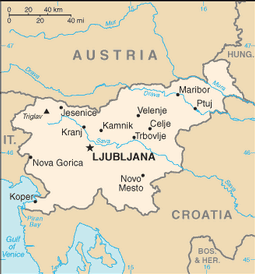Slovenia
 Slovenia is country of Europe located in central Europe.
Slovenia is country of Europe located in central Europe.
Details
| Official Name: | Republic of Slovenia |
| Capital: | Ljubljana |
| Total area: | 20 273 km2 |
| GDP per capita: | $28,195 |
| Native Language: | Slovene |
| Government: | Unitary parliamentary constitutional republic |
| Population: | 2,055,496 |
| Major Religion: | Roman Catholicism |
| Monetary Unit: | Euro (EUR) |
Previously one of Yugoslavia’s six constituent republics, present-day Slovenia became independent in 1991 as Yugoslavia fell apart. It is bordered by Italy, Austria, Hungary and Croatia.
Four major European geographic regions meet in Slovenia: the Alps, the Dinaric area, the Pannonian plain and the Mediterranean. The country is mountainous, and Slovenes are keen skiers and hikers. The national flag depicts the three-peaked Triglav, Slovenia’s highest mountain at 2 864 metres.
The country was once part of the Austro-Hungarian Empire. The capital, Ljubljana, was founded in Roman times. Its university, with more than 50 000 students, contributes to the city’s busy cultural life. The main industries are car parts, chemicals, electronics, electrical appliances, metal goods, textiles and furniture.
Tourist attractions include the famous caves at Postojna, with their decor of stalactites and stalagmites. Graffiti in the caves shows that the first tourists came here in 1213.
Slovenian cuisine is strongly influenced by that of its neighbours. From Austria comes Strudel and Wiener Schnitzel . Italy has contributed risotto and ravioli and Hungary goulash. The potica is a traditional Slovenian cake made by rolling up a layer of dough covered with walnuts.
Among the most famous Slovenes are the physicistJožef Stefan, the linguistFranc Miklošič and the architect Jože Plečnik.
Health & Welfare
Comprehensive health and welfare benefits including pension, disability, and choice of public or private health care provider.
Economy & Jobs
Agriculture, tourism, and electrical machinery.
Main Attractions
Ljubljana, Adriatic coast beach towns, Julian Alps, and Škocjan caves
Economy
Slovenia today is a developed country that enjoys prosperity and stability, as well as a GDP per capita at 88% of the EU27 average. It was the first new member of the European Union to adopt euro as a currency in January 2007, and it has been member of the Organisation for Economic Co-operation and Development since 2010.
Slovenia has a highly educated workforce, well-developed infrastructure, and is situated at a major transport crossroad. On the other side, the level of foreign direct investment is one of the lowest, and the Slovenian economy has been severely hurt by the European economic crisis, started in late 2000s. Almost two thirds of people are employed in services.
Immigration and residency
If you are interested in moving to the countries, either with a residence permit or by acquiring a citizenship, please contact us, and also get acquainted with the relevant migration documents.